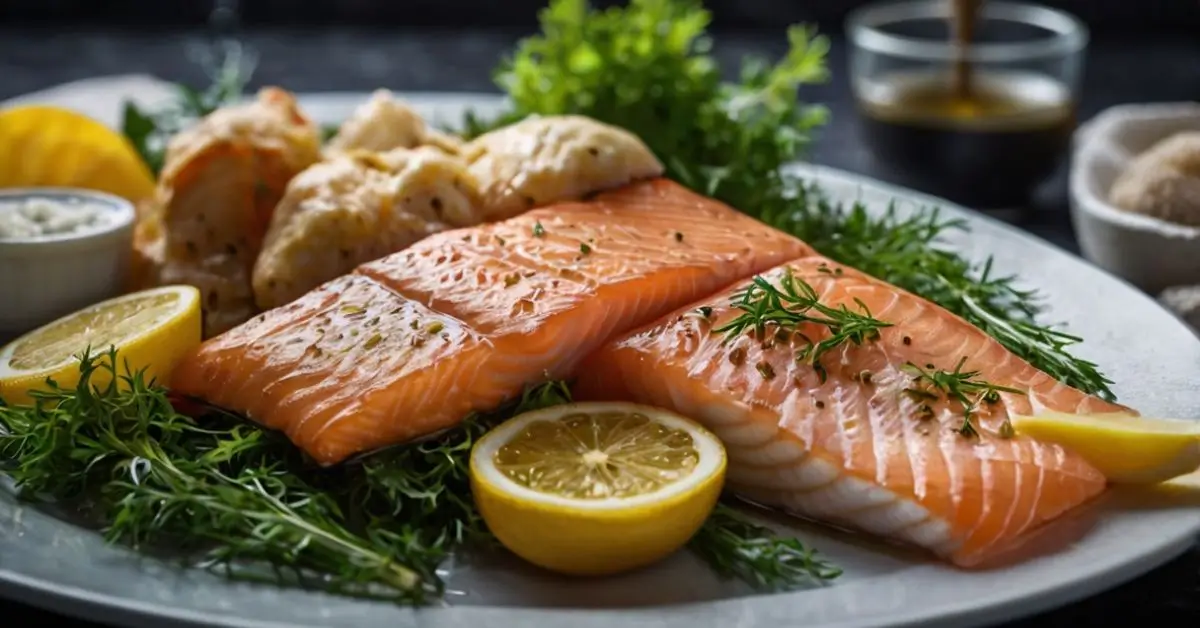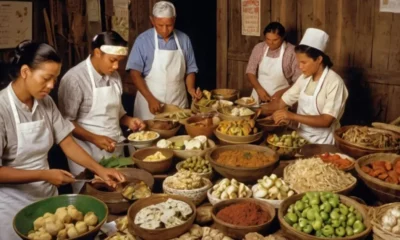FOOD & DRINKS
What Animals Are Food in France?

France is widely celebrated for its rich culinary tradition, renowned globally for its gourmet dishes and fine wines. But what animals are food in France? This question can spark curiosity, especially for those unfamiliar with the country’s eating habits. The French culinary landscape is diverse, with a variety of animal-based ingredients taking center stage in traditional dishes. From classic meats like beef and pork to more exotic delicacies such as frogs and snails, animals feature prominently in French cuisine.
We will explore the various animals that make up the foundation of French dishes. We’ll provide insight into common and less common meats used in France, their cultural significance, and some key dishes that highlight them. So, if you’re looking to understand what animals are food in France and why they are central to French cooking, keep reading.
Profile Summary
| Aspect | Details |
|---|---|
| Cuisine Type | French cuisine is diverse, influenced by regional variations. |
| Focus Keyword | What animals are food in France? |
| Common Meats | Beef, chicken, lamb, pork, duck, and rabbit are commonly used. |
| Exotic Meats | Frog legs, snails, horse meat, and game meats like venison. |
| Cooking Styles | French cooking methods vary by region and often involve slow roasting, braising, and grilling. |
What Animals Are Food in France? – A Comprehensive Guide
In France, meat consumption varies from the commonly known to the more unusual. French cuisine is deeply tied to the country’s agricultural history, which is why different regions feature different types of animal-based foods. The love for animal protein in French cooking is also visible in their penchant for rich sauces, such as béchamel, velouté, and hollandaise, which accompany many meat-based dishes.
Here, we will break down the common and exotic animals used for food, as well as their role in French gastronomy.
1. Beef (Boeuf)
Beef is one of the most prominent meats in French cuisine. French beef is known for its quality, with various breeds such as Charolais, Limousin, and Aubrac producing tender cuts that are enjoyed across the country.
One of the most famous dishes in French cuisine is steak frites, a simple yet iconic meal consisting of a beef steak paired with crispy fries. Another classic is boeuf bourguignon, a slow-cooked beef stew simmered in red wine, with onions, mushrooms, and bacon. The use of beef in French cuisine is central, particularly in regions like Burgundy, where beef dishes are often paired with rich wines.
2. Chicken (Poulet)
Chicken, known as poulet in French, is another mainstay in French cuisine. It is used in a wide variety of dishes, from the humble coq au vin, which is rooster cooked in red wine, to poulet rôti, a simple yet elegant roasted chicken dish. The most prized variety is the Bresse chicken, known for its flavorful and tender meat, a luxury item often served in the finest French restaurants.
The versatility of chicken in French kitchens cannot be overstated, as it can be prepared in almost any form – roasted, stewed, grilled, or even made into a pâté.
3. Lamb (Agneau)
Lamb holds a special place in the culinary traditions of France, especially in rural and Mediterranean regions. Known as agneau in French, lamb is typically prepared for special occasions and festive meals. In regions like Provence, lamb is often roasted with garlic and herbs, creating a flavorful, aromatic dish. Another popular preparation is gigot d’agneau, a leg of lamb, often served with vegetables and a wine-based sauce.
Lamb also features prominently in the Navarin d’agneau, a French lamb stew cooked with root vegetables. The tenderness and delicate flavor of lamb make it a prized ingredient in French cooking.
4. Pork (Porc)
Pork, or porc in French, is another frequently used animal protein in French cuisine. Pork can be found in a variety of dishes, especially in the regions of Alsace and Brittany. French pork is often cured or prepared in sausages, such as the famous saucisse de Toulouse. Pork belly is also a staple in many French dishes, including cochon de lait rôti, where young pig is roasted slowly to achieve crispy skin and tender meat.
Paté de campagne and rillettes, two types of French pork spreads, are often enjoyed as appetizers or on a charcuterie board.
5. Duck (Canard)
Duck, or canard in French, is a beloved protein in France, particularly in southwestern regions like Gascony and Périgord. It’s often featured in cassoulet, a rich, slow-cooked stew made with beans, pork, and duck. Duck breast is also commonly pan-seared and served rare, a dish known as magret de canard.
One of the most iconic French dishes featuring duck is confit de canard, where duck legs are slow-cooked in their own fat until tender and crispy. The rich and fatty nature of duck lends itself well to French cooking, particularly in gourmet cuisine.
6. Rabbit (Lapin)
Rabbit, or lapin, is another common animal used in French cooking, especially in rural regions. Rabbit meat is lean, tender, and slightly sweet, making it perfect for dishes such as lapin à la moutarde (rabbit cooked in mustard sauce) and civet de lapin (rabbit stew). In these dishes, rabbit is typically slow-cooked to enhance its flavor.
While not as common in mainstream supermarkets, rabbit is frequently found in farmers’ markets and specialty butcher shops in France.
7. Snails (Escargots)
One of the most distinctive and infamous animals in French cuisine is the snail, known as escargots. While snails are not commonly eaten in many parts of the world, they hold a prominent place in French gastronomy, particularly as a starter or appetizer. The snails are usually cooked in garlic butter and parsley, a dish known as escargots de Bourgogne.
Escargots are a true delicacy, especially in Burgundy, where they are often prepared with a variety of herbs, butter, and wine.
8. Frogs (Grenouilles)
Frog legs, or grenouilles, are another unique and traditional dish in France. While frog legs are not eaten as frequently today, they are still served in certain regions like Provence and the Rhône-Alpes. Cuisses de grenouille are typically fried in butter, garlic, and parsley. The texture of the meat is often compared to chicken but with a distinct, mild flavor.
Frog legs are often served as an appetizer, but they can also be found in some traditional French bistros and restaurants.
9. Horse Meat (Cheval)
Though controversial, horse meat, or cheval, has been eaten in France for centuries. In some areas, horse meat is still a common part of the diet, typically sold in butcher shops that specialize in game meats. It is known for its lean texture and rich, slightly sweet flavor.
Horse meat is often used in sausages, steaks, and pâtés, although it has been subject to changing attitudes in recent years. Nonetheless, it remains a part of the traditional French meat scene.
Comparison of Popular French Animal Proteins
| Animal | Common Dishes | Culinary Region | Taste Profile | Popularity |
|---|---|---|---|---|
| Beef (Boeuf) | Boeuf Bourguignon, Steak Frites | Burgundy, Paris | Rich, tender, beefy | Very popular |
| Chicken (Poulet) | Coq au Vin, Poulet Rôti | Nationwide, Bresse | Tender, mild, versatile | Extremely popular |
| Lamb (Agneau) | Gigot d’Agneau, Navarin | Provence, Corsica | Tender, slightly gamey | Very popular in rural areas |
| Pork (Porc) | Saucisse de Toulouse, Rillettes | Alsace, Brittany | Rich, fatty, flavorful | Widely popular |
| Duck (Canard) | Confit de Canard, Magret | Gascony, Périgord | Rich, fatty, savory | Highly popular |
| Rabbit (Lapin) | Civet de Lapin, Lapin à la Moutarde | Rural France | Lean, tender, slightly sweet | Less popular, niche |
| Snails (Escargots) | Escargots de Bourgogne | Burgundy, Nationwide | Earthy, garlicky, tender | Niche but iconic |
| Frogs (Grenouilles) | Cuisses de Grenouille | Rhône-Alpes, Provence | Mild, slightly chicken-like | Niche, regional |
| Horse Meat (Cheval) | Steak de Cheval | Various rural areas | Lean, slightly sweet | Controversial, niche |
Conclusion:
To answer the question, “What animals are food in France?” it is clear that the French culinary tradition embraces a wide variety of meats. From the beloved beef, chicken, and duck, to the more unusual but traditional snails, frogs, and even horse meat, animals are an essential component of French cuisine. Each animal offers a unique flavor profile and culinary experience, contributing to the rich diversity of dishes seen across the country.
For anyone visiting France, it’s essential to explore the local dishes that highlight these animal-based foods. Whether you are trying escargots, tasting a magret de canard, or savoring a classic boeuf bourguignon, you’ll be experiencing the culinary heritage of a country that has mastered the art of cooking with animals.
Health and Fitness
FAQs
Are frog legs commonly eaten in France?
Frog legs are not a daily food but are considered a delicacy in certain regions, especially in the south of France. They are often served as appetizers in French restaurants.
Is horse meat legal to eat in France?
Yes, horse meat is legal and available in some specialty butcher shops in France, though it is not widely consumed today.
What is Bresse chicken, and why is it special?
Bresse chicken is a highly prized breed from the Bresse region of France, known for its rich flavor, tender meat, and unique blue-legged appearance. It’s considered one of the best types of chicken in the world.
How do the French typically prepare lamb?
Lamb is often roasted or braised, and it is commonly prepared with garlic, herbs, and wine in dishes like gigot d’agneau and navarin d’agneau.
What is a typical French dish with pork?
A popular French dish made with pork is saucisse de Toulouse, a flavorful sausage that is often used in stews like cassoulet.
Are snails considered a gourmet dish in France?
Yes, escargots are considered a gourmet delicacy, particularly when prepared with garlic butter and parsley. They are often served as an appetizer in fine dining establishments.

FOOD & DRINKS
What Human Foods Can Fishes Eat?

Understanding what human foods can fish eat is crucial for any aquarium enthusiast or pet owner who wants to keep their fish healthy and thriving. While fish may seem like they should only eat their specialized fish food, many human foods can be a suitable and nutritious supplement to their diet. However, not all human foods are safe for fish. This article will explore various human foods that can be safe for fish and provide a comprehensive guide on what fish can eat from your kitchen.
What Human Foods Can Fish Eat?
Fish are often regarded as delicate creatures that require specialized diets. However, many fish owners wonder if they can feed their fish human foods. The answer is yes, but with caution. Fish can benefit from several types of human food, as long as it is appropriately prepared and offered in moderation. Knowing the right kinds of human food to offer your fish can help supplement their diet, improve their health, and enhance their overall wellbeing.
Before we dive into the specifics, it’s essential to understand that different species of fish have different dietary needs. Some fish are herbivores, while others are carnivores or omnivores. Knowing the dietary habits of your fish is key to offering the right foods.
1. Vegetables and Greens
Many fish, especially herbivores and omnivores, enjoy vegetables and greens. Vegetables are a great source of essential vitamins and minerals for fish, much like they are for humans. Here are some vegetables that fish can safely consume:
- Spinach: Spinach is a nutritious green that can be fed to most fish. It is rich in vitamins A and C, which are great for maintaining healthy fish fins and skin.
- Zucchini: Zucchini is easy for fish to digest and can be cut into thin slices or chunks for easy consumption. It’s packed with water and offers a great source of fiber.
- Peas: Peas are another vegetable that can be fed to your fish. Simply blanch the peas and remove the skin before feeding them to your fish. Peas can help with digestion and alleviate bloating in fish.
2. Fruits
Certain fruits are also safe for fish, but they should only be offered occasionally and in moderation. Fruits can provide your fish with natural sugars, antioxidants, and essential vitamins. Here are some fruits that can be beneficial to fish:
- Apples: A small, thin slice of apple can be offered to your fish. Apples are a good source of fiber and vitamin C. Be sure to remove the seeds before feeding them to your fish.
- Bananas: Bananas are rich in potassium and vitamin B6. They can be mashed or sliced for easy consumption by fish.
- Melon: Watermelon, cantaloupe, and honeydew can all be given to fish. These melons are packed with water and offer a refreshing treat for your fish.
3. Proteins
Fish are also carnivorous or omnivorous at times, so they require a good source of protein. Some human proteins can be fed to your fish as long as they are properly prepared. Below are a few proteins safe for fish:
- Boiled Eggs: Boiled eggs are a high-protein treat that can be a good addition to your fish’s diet. Simply mash a boiled egg and break it into small pieces for your fish.
- Chicken (Plain and Cooked): Fish can safely eat plain, cooked chicken. Avoid any seasonings, oils, or sauces, as these can harm the fish. The chicken should be shredded into small, digestible pieces.
- Shrimp: Shrimp is a great source of protein for fish and can be offered in its raw form. However, avoid feeding fish shrimp with shells still intact, as it could pose a choking hazard.
4. Carbohydrates
Carbohydrates can be beneficial for fish, especially for species that need energy for active swimming. Here are some carbohydrate-rich human foods that are safe for fish:
- Rice: Plain, cooked rice can be fed to fish as a supplemental food. Rice is easy to digest, and many fish enjoy it. Avoid seasoning the rice with salt or butter before feeding it to your fish.
- Oats: Plain, cooked oats are another option for adding carbohydrates to your fish’s diet. Make sure to cool the oats before offering them to your fish, as hot foods can harm their digestive system.
5. Bread
In moderation, fish can eat bread. However, bread should be considered an occasional treat. Bread is not highly nutritious for fish, but it can provide some carbohydrates. Avoid feeding fish bread with added sugar, preservatives, or yeast.
6. Rice and Pasta
Plain, boiled pasta or rice can serve as an occasional food for fish. These foods are rich in carbohydrates and can be digested easily by most fish species. However, keep in mind that they should only make up a small portion of your fish’s diet.
Foods to Avoid
While many human foods are safe for fish, some should be completely avoided. These foods can be harmful to fish and could lead to digestive problems or even death. Here are some foods that should never be given to fish:
- Salty foods: Salt is toxic to fish, so never feed them any foods that are salty or contain salt. Avoid chips, salted nuts, and canned foods with high sodium levels.
- Onions and garlic: Onions and garlic can be harmful to fish and should not be part of their diet.
- Citrus fruits: Citrus fruits such as oranges, lemons, and limes should not be fed to fish. The acidity in citrus fruits can upset the fish’s digestive system.
- Spicy foods: Spicy foods such as hot peppers and any foods with spicy seasonings should be avoided as they can cause discomfort or harm to fish.
How to Feed Fish Human Foods Safely
When feeding human foods to fish, it is important to consider several factors:
- Preparation: Always prepare human foods in a way that is appropriate for your fish. For example, peel fruits and vegetables, cut them into small pieces, and cook them when necessary.
- Moderation: Human food should only be an occasional supplement to a fish’s regular diet of fish food. Overfeeding fish with human foods can lead to an imbalance in their diet and health problems.
- Avoid seasoning: Do not feed fish any human food that has been seasoned or contains oils, butter, salt, or sugar.
- Observe your fish: After offering human foods, observe your fish for any signs of discomfort or health issues. If your fish seems to struggle with digestion or refuses the food, it is better to stop offering that particular food.
Comparison of Common Human Foods for Fish
| Food Type | Fish Species | Nutritional Benefits | Frequency |
|---|---|---|---|
| Spinach | Herbivorous fish | Rich in vitamins A, C, and fiber | Weekly |
| Zucchini | Herbivorous fish | High in water content and fiber | Twice a week |
| Apple | Omnivorous fish | High in fiber and vitamin C | Occasionally |
| Shrimp | Carnivorous fish | High in protein and omega-3 fatty acids | Weekly |
| Boiled Egg | Omnivorous fish | High in protein and nutrients | Weekly |
| Oats | Omnivorous fish | Source of carbohydrates and fiber | Occasionally |
Conclusion:
There are several human foods that fish can safely eat, but moderation and proper preparation are key. By feeding your fish a balanced diet that includes both specialized fish food and safe human foods, you can provide them with a more varied and nutritious diet. Always research the dietary needs of your specific fish species and consult a veterinarian if you are unsure about certain foods.
Remember, the occasional feeding of human foods can enhance your fish’s diet and make mealtime more exciting for them, but it should not replace their regular fish food. Stay mindful of the foods that can harm fish and ensure that they are always fed safe, nutritious treats.
How to Contact Auroshikha
FAQ
1. Can I feed my fish human food every day?
No, human food should only be given occasionally as a supplement, not a daily diet.
2. Is it safe to feed fish cooked vegetables?
Yes, cooked vegetables like spinach, zucchini, and peas are safe for most fish.
3. Can I feed my fish processed human foods like chips or crackers?
No, processed foods that are salty or contain preservatives should be avoided.
4. Can I feed my fish bread?
Bread can be given to fish in moderation, but it should not be a regular part of their diet.
5. Can I feed my fish meat like chicken or beef?
Cooked, plain chicken can be fed to fish in moderation, but raw meat should not be fed.
6. Are fruits like citrus fruits safe for fish?
No, citrus fruits should never be fed to fish because their acidity can harm their digestive system.
FOOD & DRINKS
How to Contact Auroshikha: A Complete Guide for 2025

If you’re seeking to reach out to Auroshikha, you’ve come to the right place. Whether you need assistance with their products, services, or have questions regarding their offerings, knowing how to contact Auroshikha is essential. This article will provide you with all the necessary details on how to contact Auroshikha, including the most effective methods to get in touch and useful insights into their communication channels.
Profile Summary
| Feature | Details |
|---|---|
| Company Name | Auroshikha |
| Industry | Spiritual products, Incense, Fragrances, and natural wellness products |
| Contact Methods | Email, phone, social media, direct visits (location-based) |
| Customer Support Hours | Monday to Friday, 9:00 AM to 6:00 PM |
| Known For | High-quality incense, spiritual products, and natural wellness solutions |
What is Auroshikha?
Auroshikha is a company that offers a wide range of products, including incense, oils, and other natural wellness items. Their products are widely known for promoting spiritual well-being and providing a soothing experience. Auroshikha’s offerings are especially popular in the holistic and wellness space, and the company prides itself on its quality and craftsmanship. Over the years, they’ve built a strong customer base and earned a reputation for their commitment to sustainability and customer care.
If you wish to reach out to Auroshikha, whether it’s for inquiries, feedback, or orders, there are several ways you can do so. Below, we’ll break down each method in detail.
How to Contact Auroshikha: Methods and Channels
When trying to contact Auroshikha, you will find multiple options. Each method has its own advantages depending on the urgency of your query and your preferred form of communication.
1. Email Contact
The most formal and professional way to contact Auroshikha is through email. Email communication is ideal for detailed inquiries, feedback, and customer support requests. It’s also useful when you want to ensure that your communication is documented.
- Why Choose Email? Email is a great option for those who want a written record of their communication. It allows for a thoughtful, structured approach, especially when dealing with queries that may require explanations, attachments, or product information.
- Common Email Inquiries: Customers often use email to ask about product details, inquire about availability, or track their orders.
2. Phone Contact
Auroshikha also provides a phone contact service. This is the best option for those who prefer real-time communication and immediate feedback. When contacting Auroshikha via phone, ensure to call during their customer support hours.
- Why Choose Phone Contact? Phone calls allow you to resolve queries quickly, especially if you need answers on the spot or need to clarify details. It is particularly useful for urgent issues like order cancellations or product exchanges.
- Tips for Phone Communication: Be clear about your inquiry to help the customer service representative address your needs efficiently.
3. Social Media
Auroshikha maintains an active presence on various social media platforms. Social media is an excellent option for quick communication, especially if you want to follow the latest updates, promotions, or have informal inquiries.
- Why Choose Social Media? Social media offers a more relaxed, engaging way to connect with the brand. It’s great for real-time interactions, and you can also stay updated on any ongoing events or offers.
- Social Media Channels: Look for Auroshikha’s official profiles on popular platforms like Facebook, Instagram, or Twitter. Direct messaging via these platforms often leads to swift responses.
4. In-Person Visit (Location-Based)
For those who are near Auroshikha’s physical location, visiting the company in person is a great option. This method provides an opportunity for face-to-face interaction, which can be helpful if you want to inspect products or have specific inquiries.
- Why Choose In-Person Visits? Personal visits allow you to experience Auroshikha’s offerings firsthand and gain more detailed information. Additionally, if you’re making large orders or need assistance with a specific product, this method can offer immediate help.
5. Postal Mail
Though more traditional, sending a letter or postal mail to Auroshikha remains an option. This method is less commonly used but may still be relevant for certain types of formal communication or official correspondence.
- Why Choose Postal Mail? Postal mail is most commonly used for official matters that require a physical letter or documentation. It is slower compared to other methods but can serve as a formal way of reaching out for specific requests or disputes.
6. Contact Form on Website
Some companies, including Auroshikha, offer a contact form on their website. This form allows you to submit inquiries directly, and the company’s team will get back to you via email or phone.
- Why Choose a Contact Form? A contact form is a quick and efficient way to submit your query without needing to compose a full email. It’s especially useful for routine inquiries or if you’re seeking a response from a specific department within the company.
Comparison Chart: Contact Methods for Auroshikha
| Contact Method | Advantages | Best For | Response Time |
|---|---|---|---|
| Documented communication, clear & structured | Detailed inquiries, order updates, feedback | 24-48 hours | |
| Phone | Real-time interaction, immediate answers | Urgent issues, quick clarifications | Immediate to 24 hours |
| Social Media | Quick, informal interaction, real-time updates | Promotions, casual inquiries, updates | Instant to 12 hours |
| In-Person Visit | Direct, hands-on experience, face-to-face | Product inspection, large orders, inquiries | Immediate |
| Postal Mail | Formal, documented | Legal issues, formal requests | 5-7 business days |
| Contact Form | Easy submission, structured responses | Routine inquiries, customer service | 24-48 hours |
Best Practices for Contacting Auroshikha
- Be Clear and Concise: Whether you are reaching out via email, phone, or social media, always be clear and concise with your inquiry. This will help the customer service team respond more effectively and in a timely manner.
- Provide Relevant Information: When contacting Auroshikha, provide all necessary information, such as order numbers, product names, and any relevant details that will help speed up the process.
- Respect Business Hours: Auroshikha’s customer service operates during specific hours, so be sure to contact them within these times to avoid delays.
- Follow-Up: If you don’t receive a response within the expected timeframe, consider following up. For urgent inquiries, phone calls are generally the best option.
Conclusion
Knowing how to contact Auroshikha is key to resolving your concerns, whether you’re seeking more information about their products or need customer support. From email and phone support to social media and even in-person visits, Auroshikha offers a variety of ways to get in touch. By understanding the available contact methods, you can choose the most effective option based on your needs. Make sure to stay patient and respectful of their response times to ensure the best possible customer service experience.
Homer Foods
FAQ
1. What is the best way to contact Auroshikha for urgent issues?
For urgent issues, calling Auroshikha directly is the fastest way to get a response.
2. How long does it take for Auroshikha to respond to email inquiries?
Auroshikha typically responds to email inquiries within 24-48 hours.
3. Can I visit Auroshikha in person to ask questions?
Yes, if you are located near their physical store, you can visit in person for detailed inquiries or product inspection.
4. Is there a contact form on Auroshikha’s website?
Yes, Auroshikha provides a contact form on their website for submitting inquiries.
5. Are social media messages answered by Auroshikha quickly?
Yes, social media is a fast method to get in touch with Auroshikha, and they often respond within a few hours.
6. Can I use postal mail to contact Auroshikha for official matters?
Yes, for formal or legal issues, postal mail is an option, although it takes longer to receive a response.
FOOD & DRINKS
What Does Homer Foods Sell? Homer Foods Products

When it comes to discovering high-quality, fresh, and diverse food options, many people turn to reputable food companies. One such company, Homer Foods, has steadily gained recognition for its impressive variety of products that cater to different tastes and dietary needs. But, what does Homer Foods sell? In this article, we will take a detailed look at the diverse range of products that Homer Foods offers, including everything from fresh produce and meats to baked goods and snacks.
Profile Summary of Homer Foods
| Feature | Details |
|---|---|
| Company Focus | Fresh, high-quality food products |
| Product Range | Fresh produce, meats, bakery items, snacks |
| Target Audience | Households, food lovers, health-conscious buyers |
| Quality | High standards for freshness and sourcing |
| Delivery Services | Provides home delivery in select regions |
| Market Reach | Local and regional, expanding into broader areas |
What Does Homer Foods Sell? Exploring the Product Categories
Homer Foods offers a variety of products that cater to customers’ diverse food preferences and lifestyles. Whether you’re looking for organic items, quick snacks, or gourmet delicacies, Homer Foods is dedicated to providing premium quality food. Here’s a breakdown of the categories they specialize in:
1. Fresh Produce
One of the cornerstones of Homer Foods’ offerings is fresh produce. The company prides itself on sourcing high-quality, locally grown fruits and vegetables. From crisp salads to juicy fruits and hearty root vegetables, Homer Foods ensures its produce is handpicked for maximum flavor and nutritional value. Customers can find:
- Organic fruits and vegetables
- Seasonal produce
- Locally sourced options
2. Meats and Seafood
Homer Foods also has a fantastic selection of fresh meats and seafood. The company ensures that all their meat and seafood products are carefully selected from trusted farms and suppliers. With a focus on quality, Homer Foods offers a range of:
- Grass-fed and hormone-free meats
- Fresh cuts of beef, pork, lamb, and chicken
- Wild-caught seafood and shellfish
- Sustainable and ethically sourced options
3. Dairy and Eggs
For those who rely on dairy and eggs for their nutrition, Homer Foods provides a range of products that are both nutritious and delicious. Whether you prefer whole, skim, or plant-based alternatives, Homer Foods has something to suit every taste. Their dairy section includes:
- Fresh milk, cream, and butter
- A variety of cheeses, including aged and artisanal selections
- Eggs from free-range hens
- Plant-based dairy alternatives
4. Bakery Goods
If you’re in the mood for freshly baked bread or delicious pastries, Homer Foods has got you covered. Their bakery section includes a wide selection of freshly baked goods, from hearty loaves of sourdough to sweet treats like cookies and cakes. Products available include:
- Freshly baked artisan bread
- Pastries and cakes
- Gluten-free and low-carb options
- Homemade pies and tarts
5. Snacks and Beverages
Homer Foods also carries a wide range of snacks and beverages for those looking for a quick bite or refreshing drink. Whether you’re looking for something healthy, indulgent, or both, you’ll find options to satisfy your cravings. Their offerings include:
- Organic chips, granola bars, and nuts
- Health-conscious snacks like veggie crisps and protein bars
- A variety of juices, sodas, and flavored waters
- Artisanal coffee and loose-leaf tea
6. Frozen Foods
Frozen foods are perfect for busy households, and Homer Foods offers a variety of options in this category. Whether you need quick meal solutions or want to stock your freezer with convenient foods, Homer Foods delivers premium frozen options that maintain flavor and nutritional content. Frozen items available include:
- Frozen fruits and vegetables
- Ready-to-cook frozen meals
- Frozen seafood and meats
- Frozen desserts, such as ice cream and sorbets
7. Health and Wellness Products
As people become more health-conscious, Homer Foods has expanded its range to include health and wellness products. This includes everything from nutritional supplements to specialty foods designed for specific dietary needs. Customers can find:
- Gluten-free and vegan products
- Organic snacks and ingredients
- Protein powders and vitamins
- Low-sugar and low-carb options
8. Prepared Meals
For those who are short on time but still want a home-cooked meal, Homer Foods offers prepared meal options that are both delicious and convenient. The prepared meals are made with high-quality ingredients and are designed to suit various dietary needs. Some of the options include:
- Healthy bowls and salads
- Hearty soups and stews
- Gourmet meals for special occasions
- Family-sized meal kits for easy cooking
9. Condiments, Sauces, and Spices
To enhance the flavor of any dish, Homer Foods carries a wide variety of condiments, sauces, and spices. Their selection includes everything from classic favorites to unique and hard-to-find ingredients, perfect for cooking enthusiasts. Some of the items available include:
- Specialty hot sauces, dressings, and marinades
- Organic oils, vinegars, and seasonings
- Gourmet salts and pepper blends
- Fresh herbs and dried spices
Comparison Chart: Homer Foods vs. Competitors
| Category | Homer Foods | Competitor A | Competitor B |
|---|---|---|---|
| Fresh Produce | Locally sourced, organic options | Limited organic selection | Mainly conventional produce |
| Meats and Seafood | Grass-fed, hormone-free, sustainable | Focus on conventional meat options | Offers some organic options |
| Dairy and Eggs | Free-range eggs, plant-based options | Limited plant-based options | Traditional dairy with fewer alternatives |
| Bakery Goods | Freshly baked artisan breads and pastries | Pre-packaged items from factories | Limited bakery selection |
| Snacks and Beverages | Organic snacks, wide beverage selection | Healthy snacks only | Variety of snacks but fewer organic |
| Health & Wellness | Variety of gluten-free, vegan options | Focus on traditional health items | Limited health-conscious options |
This comparison chart highlights the strengths of Homer Foods in providing diverse, high-quality products compared to some of its competitors in the food industry. Homer Foods’ commitment to offering locally sourced, organic, and sustainable items sets them apart from others, ensuring customers enjoy the best products available.
Why Choose Homer Foods?
When choosing Homer Foods, customers can expect not only a wide variety of products but also a focus on quality and sustainability. Their commitment to sourcing fresh, local ingredients and offering a wide selection of health-conscious options makes them a go-to choice for many consumers. Whether you’re cooking from scratch, need a quick snack, or want gourmet options, Homer Foods has something for everyone.
Conclusion:
Homer Foods sells a wide variety of premium food products, ranging from fresh produce and meats to bakery goods and health-conscious snacks. Their dedication to quality, sustainability, and offering a diverse range of items makes them a favorite choice among consumers. With products that cater to various dietary needs and preferences, Homer Foods stands out in the competitive food industry as a leader in offering high-quality, fresh, and innovative food options.
FAQ’s
- What kind of produce does Homer Foods offer?
- Homer Foods offers a wide selection of fresh, locally sourced produce, including organic fruits and vegetables, seasonal items, and more.
- Does Homer Foods sell meat and seafood?
- Yes, Homer Foods provides a range of grass-fed meats, hormone-free options, and sustainably sourced seafood.
- Can I find gluten-free products at Homer Foods?
- Yes, Homer Foods offers a variety of gluten-free options, including snacks, baked goods, and prepared meals.
- Does Homer Foods offer organic dairy?
- Yes, Homer Foods carries organic dairy products, including milk, butter, cheese, and plant-based dairy alternatives.
- Are the bakery items from Homer Foods fresh?
- Absolutely! Homer Foods provides freshly baked artisan bread, pastries, and cakes, made daily with high-quality ingredients.
- Does Homer Foods offer home delivery services?
- Yes, Homer Foods provides home delivery in select regions, allowing customers to conveniently shop for fresh food online.
-
TECHNOLOGY2 weeks ago
66 Celsius to Fahrenheit: A Comprehensive Guide
-
GENERAL2 weeks ago
MyFastBroker Mortgage Brokers: Your Guide to Finding the Right Mortgage Solutions
-
BUSINESS2 weeks ago
Ecrypto1.com Crypto Exchange: Everything You Need to Know
-
HEALTH1 week ago
Athens Health and Fitness: Your Ultimate Guide to Wellbeing and Wellness
-
FOOD & DRINKS1 week ago
What Countries Influence Yankeeland Region Food: A Culinary Journey
-
FOOD & DRINKS1 week ago
How to Contact Auroshikha: A Complete Guide for 2025
-
HEALTH7 days ago
Trenton Total Health Care: Your Path to Comprehensive Wellness
-
HEALTH7 days ago
Dermatology and Skin Health: Your Guide to a Radiant Complexion















